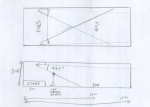Hey all,
So in the next round of my house guy hustle I am getting involved with an artsy venue looking to branch out more into live music. The room in question has a 3m x 6m stage. FOH is about 10m back, and the back wall is about 15m from the stage. Where it gets tricky quite quickly is that the ceiling is about 3.45m.
Current PA is a set of ancient 10"/1" jbl sound power speakers, which would have basically worked, but a wall was removed to increase the dancefloor size. The owner wants to invest in a better system. An issue with the current system is that the highs are basically gone after 6m. The owner also had a pair of rcf art310a's to test with, and the same issue is there. I was not involved in the deployment of either. The subs are fine for now.
Potential powering is just a driverackPA and the available amps are nothing id want to depend on, so something like an inuke dsp amp for passive speakers would be ideal.
Would you guys recommend a louder top with a wide (say 60 degrees) vertical horn angle and/or delayed speakers? Based on the venue design, the delays would likely be 6m away from the stage, a few meters in front of foh. Music ranges from jazz to indie rock
Budget is ideally 2k€, but arrangements up to 8k€ can be done if it is special enough. I know this will be tough with new speakers, so i am scouring what is available used. Rider friendliness is not a concern, only potential resell value (i.e. nothing homemade, not matter how nice).
thx for any ideas
So in the next round of my house guy hustle I am getting involved with an artsy venue looking to branch out more into live music. The room in question has a 3m x 6m stage. FOH is about 10m back, and the back wall is about 15m from the stage. Where it gets tricky quite quickly is that the ceiling is about 3.45m.
Current PA is a set of ancient 10"/1" jbl sound power speakers, which would have basically worked, but a wall was removed to increase the dancefloor size. The owner wants to invest in a better system. An issue with the current system is that the highs are basically gone after 6m. The owner also had a pair of rcf art310a's to test with, and the same issue is there. I was not involved in the deployment of either. The subs are fine for now.
Potential powering is just a driverackPA and the available amps are nothing id want to depend on, so something like an inuke dsp amp for passive speakers would be ideal.
Would you guys recommend a louder top with a wide (say 60 degrees) vertical horn angle and/or delayed speakers? Based on the venue design, the delays would likely be 6m away from the stage, a few meters in front of foh. Music ranges from jazz to indie rock
Budget is ideally 2k€, but arrangements up to 8k€ can be done if it is special enough. I know this will be tough with new speakers, so i am scouring what is available used. Rider friendliness is not a concern, only potential resell value (i.e. nothing homemade, not matter how nice).
thx for any ideas

